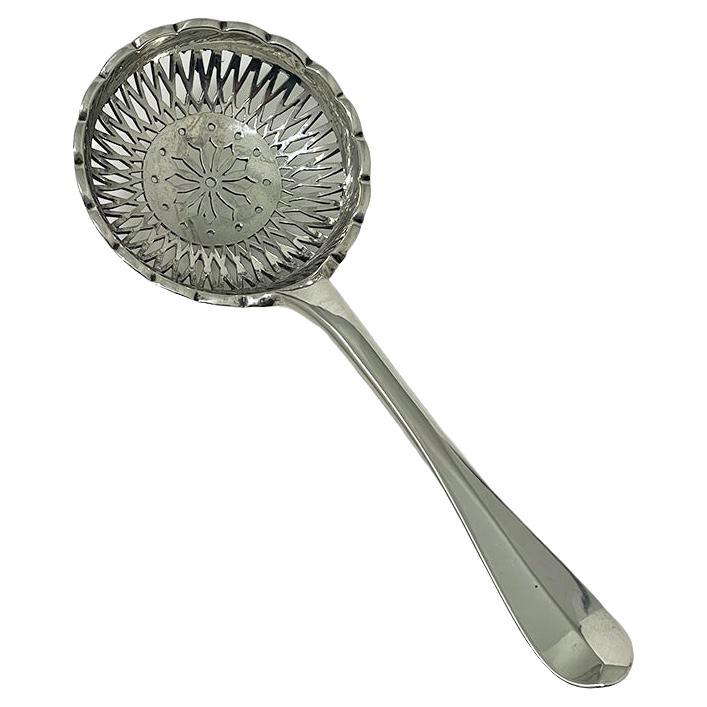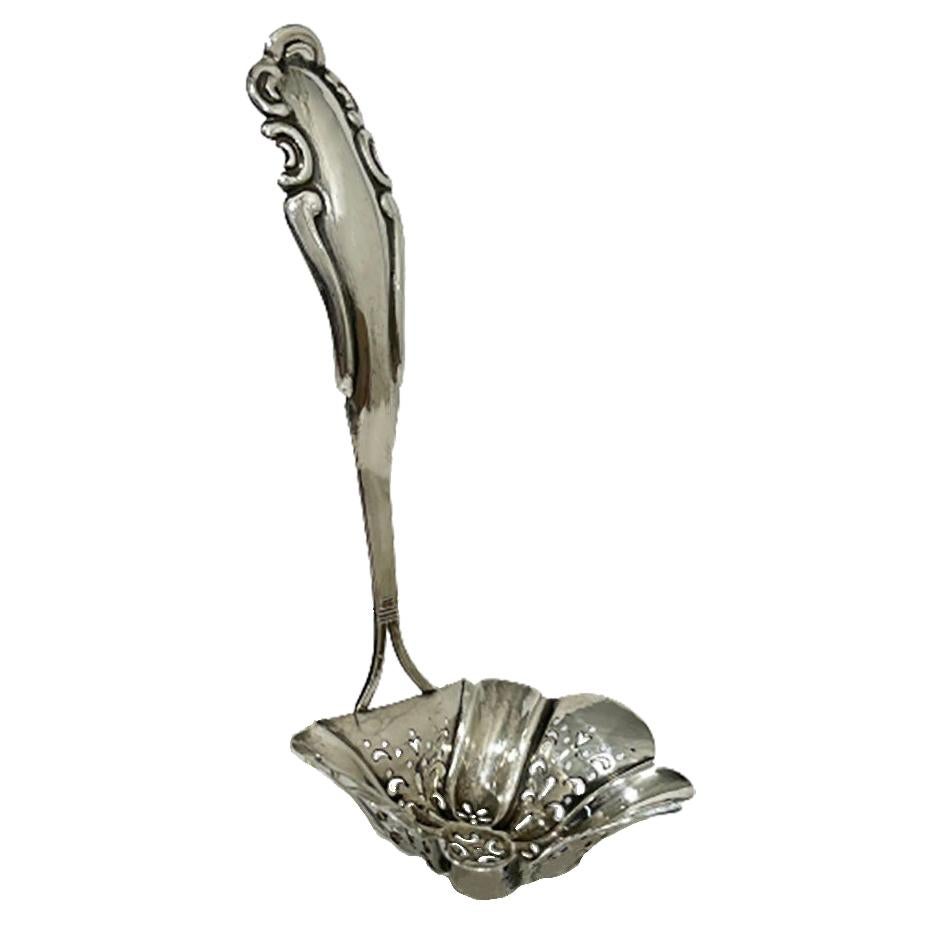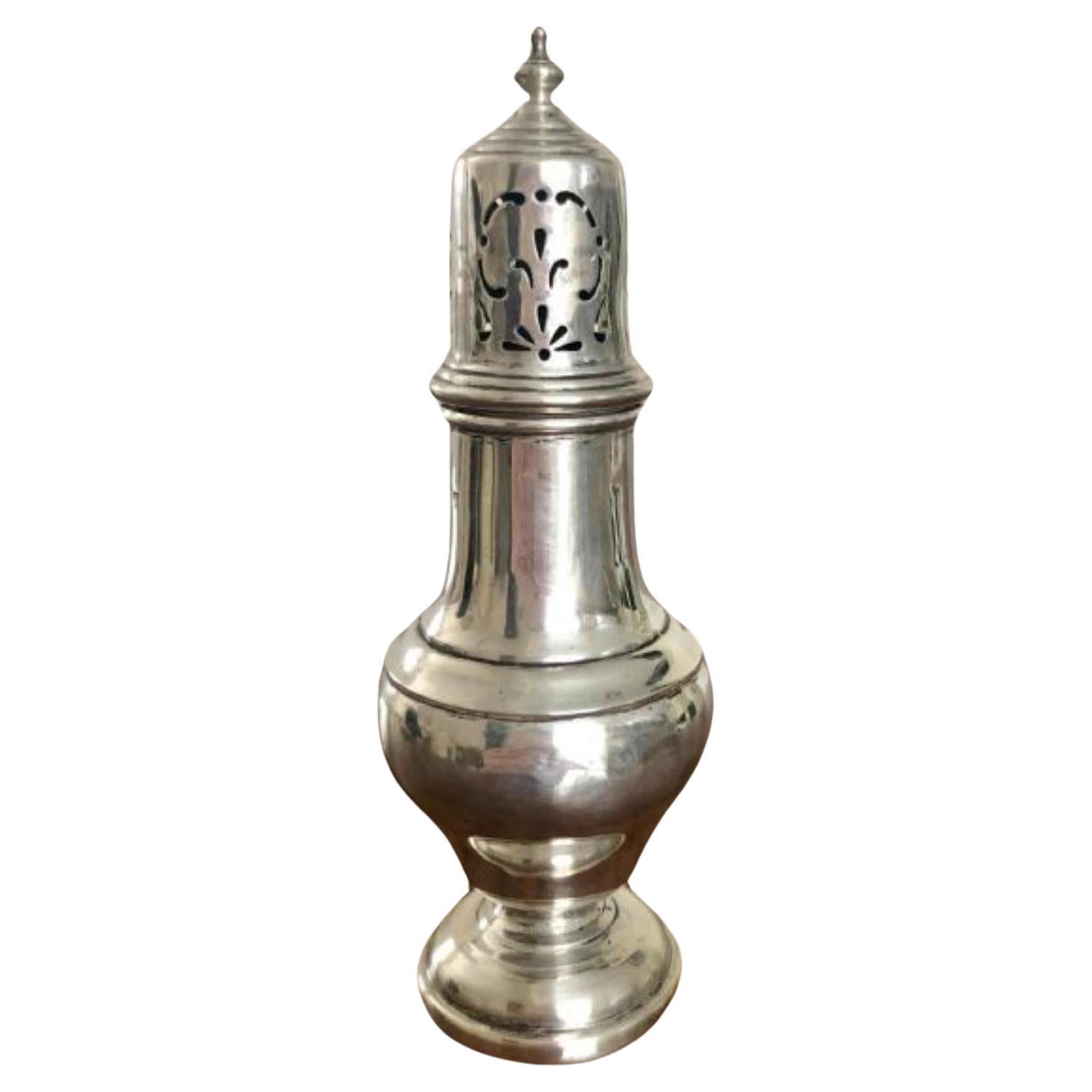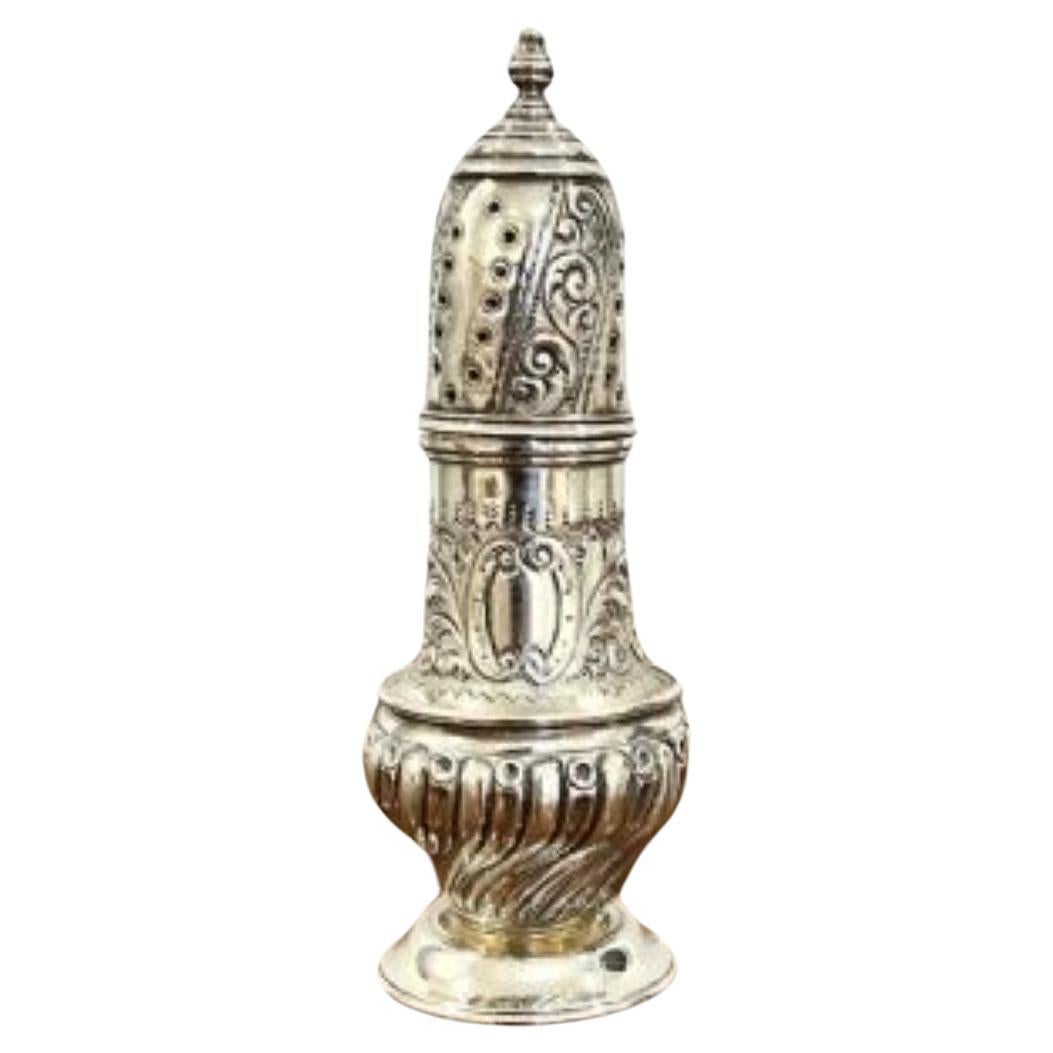Items Similar to Dutch Military Silver Snipe Sugar Sifter
Want more images or videos?
Request additional images or videos from the seller
1 of 19
Dutch Military Silver Snipe Sugar Sifter
About the Item
The Silver sifter in the form of a Snipe bird with long pointed bill, short wings and short legs. The Snipe cast in solid silver with multiple hallmark located around the collar, removable sifter, and leg. Hallmarks include a passant lion facing right used to indicate second standard of purity with a minimum .833 , a straight sword used between 1906-1953 and date letter J for 1919. Each hallmark located with one on each piece used particularly on larger pieces of Silver. The Snipe is mounted upon an ebonised wooden plinth with two silver plaques reading “Presented to Major J.A.G Le Coq on the Occasion of his Marriage 25th Sept 1954, From the Officers of the 60th Rifles.”
The 60th Rifles (The King’s Royal Rifle Corps) were an infantry regiment formed in 1756. They were one of the first regiments in the British Army to be equipped with rifles. Over the years the regiment gained 5 battalions and fought in most prominent wars around the world including American War of Independence (1775-83), Peninsular War (1808-14), American Civil War (1861-65), Boer War (1899-1900) and both the First and Second Word War. In 1966 the regiment merged with the two other regiments of the Green Jackets Brigade to form The Royal Green Jackets.
Measurements (centimetres) 21cm High x 30cm Long x 11cm Wide Inc Base
- Dimensions:Height: 8.27 in (21.01 cm)Width: 11.81 in (30 cm)Depth: 4.33 in (11 cm)
- Style:Dutch Colonial (In the Style Of)
- Materials and Techniques:
- Place of Origin:
- Period:
- Date of Manufacture:1919
- Condition:Wear consistent with age and use.
- Seller Location:Newark, GB
- Reference Number:
About the Seller
5.0
Vetted Seller
These experienced sellers undergo a comprehensive evaluation by our team of in-house experts.
Established in 2019
1stDibs seller since 2022
19 sales on 1stDibs
Typical response time: <1 hour
- ShippingRetrieving quote...Ships From: Newark, United Kingdom
- Return PolicyA return for this item may be initiated within 14 days of delivery.
More From This SellerView All
- Chinese Export Silver Basket Wang HingBy Wang Hing & Co.Located in Newark, EnglandFine Chinese silver basket (bon-bon dish/bridal basket) circa 1900. The presentation basket of circular form expertly crafted with spigs of blossoming flowers to the outer boarder ho...Category
Antique Early 1900s Chinese Qing Sterling Silver
MaterialsSilver
- Silver Horse Cigarette Case AspreyBy Asprey International LimitedLocated in Newark, EnglandHallmarked Asprey, London The case of flat rectangular form with a splayed lid and base featuring a neat engine turned pattern throughout. The lid with a high quality engraved horse...Category
Mid-20th Century English Mid-Century Modern Sterling Silver
MaterialsSilver, Sterling Silver
- Silver and Enamel Cigarette Case ViennaLocated in Newark, EnglandHallmarked From our Silver collection, we are delighted to offer this Art Nouveau Silver and Enamel Cigarette Case from Vienna, Austria. The Silver and Enamel Cigarette Case of stunning Art Nouveau design with a central enamel scene depicting the legend of St. Hubert, Patron Saint of hunters with the divine deer. The scene features St. Hubert in the foreground dressed much like the later Robin Hood with feathered cap carrying a cross bow. In the background the divine deer stands on a river bank with long antlers portraying a crucifix between them amongst foliage and trees. The Scene flanked by Art Nouveau design upon a Silver case with push button thumb tab. The interior of the Cigarette Case is finished in silver-gilt with an inscription to the left hand side reading Mr et Mdme. Dr Groedel Hietzing 20/VII 1900. (20/07/1900). The Silver and Enamel Cigarette Case is hallmarked twice on the thumb tab, once below the ‘1900’ and twice on the right hand side of the inner case. The last hallmarks feature an illegible makers mark however it is clear that the hallmarks show the hexagonal Dianakopf (Diana’s head) mark showing the silver is .900 fineness and dated to between 1872-1922 inline with the inscription date of 1900. Dianakopf (Diana’s Head) was first used in 1867 the cartouche shape and number within indicate the silver fineness. Beginning in 1872, a letter was added to indicate city of assay. The hallmark comes in varied shapes depending on the year and fineness. Hietzing is the 13th municipal District of Vienna. It is located west of the central districts, west of Meidling. Hietzing is a heavily populated urban area with many residential buildings but also contains large areas of the Vienna Woods, along with Schönbrunn Palace. St. Hubert The legend of St. Hubert holds that on a Good Friday morning, while the faithful were in church, Hubert was hunting in the forest. As he pursued a magnificent stag or hart, the animal turned and Hubert was astounded to see a crucifix floating between its antlers. He heard a voice saying: “Hubert unless thou turnest to the Lord and leadest a holy life, thou shalt quickly go down into Hell.” Hubert dismounted and prostrated himself, and after asking “Lord, what wouldst thou have me do?” is told, “Go and seek Lambert, and he will instruct you.” The story of the stag first appears in one of the later legendary hagiographies (Bibliotheca hagiographic Latina, nos. 3994–4002) and has been appropriated from the legend of Saint Eustace...Category
Antique Early 1900s Austrian Art Nouveau Sterling Silver
MaterialsSilver, Enamel
- German Silver Gilt Minaudière Louis KuppenheimBy Louis KuppenheimLocated in Newark, EnglandThe minaudière of rectangular form with curved corners features a repousse monkey which humorously goes through the case with the front side of the monkey on the cover and the rear side of the monkey on the back. The exterior of the case is gilded Silver with cabochon Sapphires and a top carry loop. To the left of the top a second loop contains the original pencil which pulls out for taking notes upon the ivorine notepad within. The interior of the case features several compartments which open via the Sapphire tabs, the left side contains two smaller compartments while the right side features a bevel edged mirror with an ivorine notepad to the reverse and a spring loaded tab to the compartment. The case is hallmarked in several locations with the London ‘omega’ import mark (1906-1998), the import Silversmiths mark Gresham Barber & Co and is dated 1907. Although the minaudière does not bear the original makers hallmark we firmly attribute the case to Louis Kuppenheim a renowned German Silversmith who made designs matching this minaudière. Louis Kuppenheim (1824-1889)was founded in 1854 together with Heinrich Witzemann they were located in Pforzheim, southwestern Germany and is known as the gateway to the Black Forest. In 1857 Kuppenheim moved forward as a solo business without his partner and moved to Durlacher Straße 1, Old Town street in Pforzheim. Upon the death of Louis Kuppenheim in 1889 3 of his 6 children (Albert, Hugo and Moritz) took over running the company and in 1900 at the Universal Exhibition in Paris the firm won a gold medal for a paper knife. In the same year the company opened the first store in the Rue de Richelieu 67 in Paris. In the 1900s Hans Christiansen designed some silver parts and pieces of jewellery, which were made by the Manufacture Kuppenheim. Christiansen was an important Art Nouveau painter and a member of the Darmstadt artists’ colony. In 1906 Albert, Hugo and Moritz convert the inherited jewellery factory into a modern gold and silverware fabrication and one year later relocated to 69 Durocher Street. Over the next 30 years the company expanded their business with mechanical workshops for gold and silver along with more machinery along with the death of Albert Kuppenheim and Ludwig (another son of Louis) taking over the company. After the war broke out in 1939 the company went into liquidation ending its 82 year history. During the heyday of the company over 200 people were employed by Louis Kuppenheim making it one of the most important employers in the jewellery city of Pforzheim. In the more than eighty years of production some 100,000 pieces left the company. Kuppenheim made many items in small series, for example boxes and minaudières (women’s fashion accessory, generally considered a jewellery piece, intended to substitute for an evening bag. A case with compartments, it allows storage for several items in a small space, such as a makeup compact, lipstick, watch, reading glasses, or keys) and compacts and cigarette cases...Category
Antique Early 1900s German Art Nouveau Sterling Silver
MaterialsGold Plate, Silver
- George III Silver Teapot Peter & Ann BatemanBy Peter and Ann BatemanLocated in Newark, EnglandHallmarks Dated 1796 From our Silver collection, we are delighted to offer this original George III Silver Teapot by Peter & Ann Bateman. The...Category
Antique Late 18th Century English George III Sterling Silver
MaterialsSilver, Cut Steel
- George III Erotic Silver Vinaigrette by Joseph Ash IBy Joseph Ash ILocated in Newark, EnglandFine and very rare erotic silver vinaigrette. The vinaigrette of circular form with removable lid revealing the grill containing the sponge underneath. T...Category
Antique Early 1800s British George III Sterling Silver
MaterialsSilver
You May Also Like
- Dutch silver sugar sifter serving spoon by Th.H. Saakes, 1918Located in Delft, NLDutch silver sugar sifter serving spoon by Th.H. Saakes, 1918 A Dutch silver sugar sifter spoon made by Th. H. Saakes in The Haque. The hall...Category
20th Century Dutch Sterling Silver
MaterialsSilver
- Dutch Silver Bierdermeier Sugar Sifter spoon by Hendrik Van der Ree, 1850Located in Delft, NLDutch Silver Bierdermeier Sugar Sifter spoon by Hendrik Van der Ree, 1850 A silver sugar sifter serving spoon made by the Silver smith Hendrik van der Ree, worked during 1841-1853 i...Category
Antique 19th Century Dutch Sterling Silver
MaterialsSilver
- Antique Edwardian Hall Marked Silver Sugar SifterLocated in Ipswich, GBAntique Edwardian hall marked silver sugar sifter, having a pierced removable top above a shaped vessel on a circular baseCategory
Early 20th Century Edwardian Sterling Silver
MaterialsSilver
- Quality antique Victorian hallmarked solid silver sugar sifterLocated in Ipswich, GBQuality antique Victorian hallmarked solid silver sugar sifter having a quality antique Victorian hallmarked solid silver sugar sifter with a pierced removable top, with detailed lea...Category
Antique Early 19th Century Victorian Sterling Silver
MaterialsSilver
- Fine Regency Period Sterling Silver Sugar Sifter, Hallmarked Glasgow, 1826By John MitchellLocated in Ottawa, OntarioA fine early 19th century George IV sterling silver sugar sifting ladle, showing a finely pierced bowl and bearing Glasgow Hallmarks with date marks f...Category
Antique Early 19th Century Scottish Regency Sterling Silver
MaterialsSterling Silver
- 1890s Victorian Sterling Silver Gilt Sugar Sifter Spoon and BowlBy Goldsmiths & Silversmiths Co. Ltd.Located in Jesmond, Newcastle Upon TyneAn exceptional, fine and impressive antique Victorian English sterling silver sugar sifter spoon and bowl - boxed; an addition to our silver teaware collection. This exceptional antique Victorian sterling silver gilt teaware set consists of a sugar bowl and sifter spoon. The bowl has a circular rounded form to a circular spreading foot. The surface of the bowl is embellished with exceptional chased floral ornamentation accented with scroll designs, all on a matte background. The decoration to the bowl incorporates a putto* design to one side and a scrolling leaf bordered cartouche to the other, displaying the contemporary bright cut engraved crest of a unicorn before trees. The upper portion of this exceptional bowl is encircled with a broad plain border and the rim of the foot is encompassed with an applied decorated border. The exceptional sugar sifter ladle is embellished with further putto and scrolling leaf ornamentation, reflecting the design to that of the bowl. The shell shaped bowl is embellished with scrolling pierced 'sifter' holes to each scalloped flute. The reverse surface of the terminal incorporates a cartouche displaying the aforementioned crest. Each exceptional example of Victorian silverware retains the original gilding. The underside of the sugar bowl bears the retailer's mark 'Goldsmiths & Silversmiths Compy, 112 Regent St'. This antique sugar sifter...Category
Antique Late 19th Century English Late Victorian Sterling Silver
MaterialsSilver, Sterling Silver
Recently Viewed
View AllMore Ways To Browse
Sword Leg
Silver Wings Sterling
Antique Wooden Plinth
British Army Military
Mounted Sword
Sterling Silver Plaque
American Antique Plaque
War Sword
20th Century Dutch Colonial Furniture
American Sword
American War Independence
American War Of Independence
Dutch Green Glass
Carved Wooden Plinth
Colonial American Ceramics
Lion Plaques
Used Rifles
Lions With Wings





